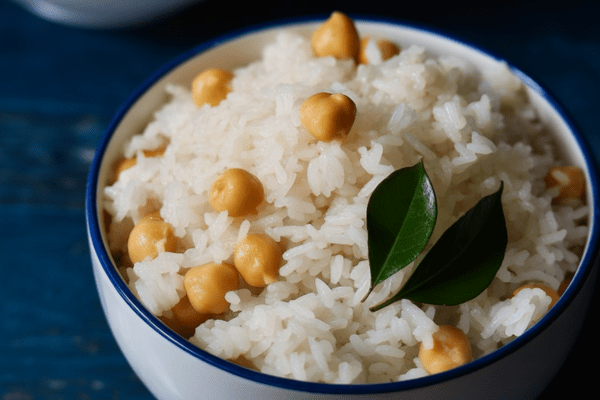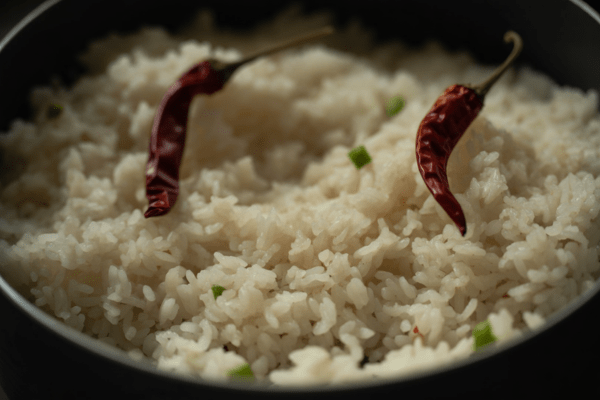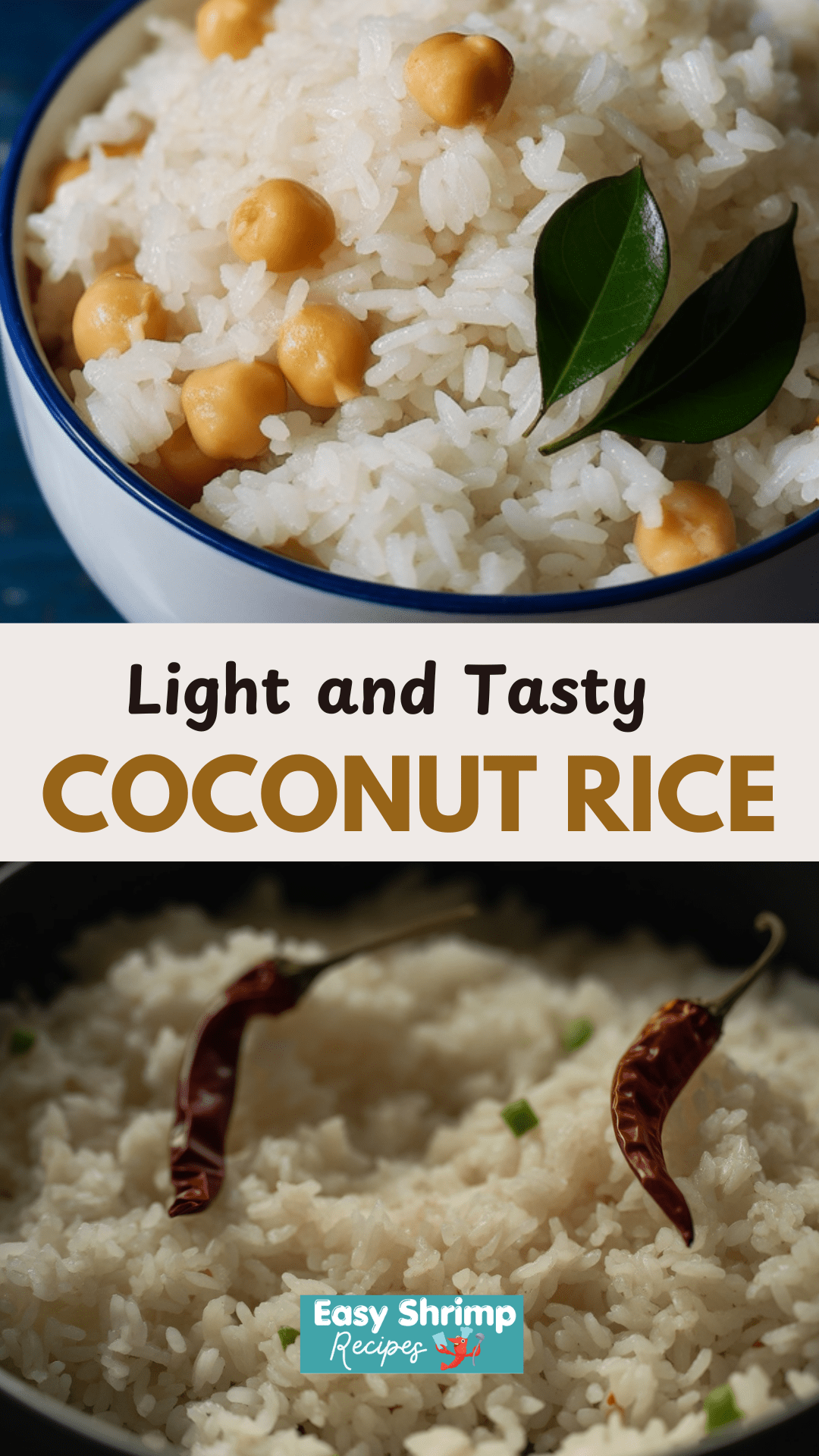If you’ve never made Coconut Rice at home, you’re in for a real treat. This South Indian classic is simple, aromatic, and deeply comforting — the kind of dish that feels both humble and festive at the same time. Whether it’s a quick weekday lunch or part of a temple-style meal spread, this rice always has a place on the table.

What I love about this dish is how it transforms a few pantry staples — cooked rice, grated coconut, and tempering spices — into something so flavorful and satisfying. And the best part? It comes together quickly, especially if you’ve got leftover rice in the fridge.
Why Coconut Rice Is a Staple in My Kitchen
This dish has become one of my favorite go-to meals, especially during the warmer months when I’m craving something light, but still flavorful. I often make it after a grocery run when I’ve picked up a fresh coconut — there’s something so satisfying about cracking it open, grating it fresh, and using it right away.
It’s also a lifesaver when I want to make something vegetarian, gluten-free, and dairy-free without missing out on flavor. That balance of crisp curry leaves, toasted lentils, crunchy cashews, and fluffy rice… it’s hard to beat.
Plus, I’ve found it’s a hit with friends who aren’t too familiar with South Indian food — it’s gentle in flavor, a little nutty, and has just enough spice to keep it interesting.
Ingredient Tips and Real-Life Notes
Rice – I usually reach for sona masuri or ponni rice when I want that traditional touch. They’re non-sticky and perfect for this dish. But I’ve also made it with basmati or leftover jasmine rice, and it turns out just fine. If your rice is a little clumpy after cooling, just break it apart with your fingers or a fork before mixing.
Grated Coconut – Fresh is hands-down the best here. The fragrance and texture are unmatched. But I’ve also used frozen coconut when I’m in a pinch. Just make sure to thaw it completely and give it a sniff — if it smells even slightly off, it’s best not to risk it.
Lentils (Urad and Chana Dal) – These give the dish its signature crunch and nutty bite. I usually soak them for 20 minutes or so while the rice is cooking, which helps them fry up evenly. If you’re short on time, you can toss them straight into the oil, but they might stay a little too firm.
Curry Leaves – Please don’t skip these. They’re the soul of this recipe. When they hit hot oil, the aroma is something else — instantly mouthwatering. If you don’t have fresh leaves, use dried or powdered curry leaves sparingly, though the flavor won’t be quite the same.
Cashews – I love the soft crunch they bring. But roasted peanuts work well too if that’s what you have on hand. Sometimes I do a mix of both, especially if I’m making a larger batch.
Chilies – I use both green and dried red chilies. The red ones add a smoky depth, while the green chilies give a sharp heat. Feel free to adjust the number depending on your spice preference — I usually go for mild when sharing with guests.
Coconut Oil – For the most authentic flavor, I always cook this in coconut oil. It adds a delicate aroma that ties everything together. If you’re not a fan, sesame (gingelly) oil is a great alternative.

My Step-by-Step Real Life Routine
Here’s how I usually pull it all together on a busy weekday:
- While soaking the rice and dals, I grate the coconut and prep the other ingredients — curry leaves, cashews, chilies.
- Once the rice is done and cooling, I start the tempering in a separate pan. The smell of mustard seeds crackling and curry leaves sizzling always makes the kitchen feel warm and alive.
- After sautéing the coconut for just a few minutes (don’t let it brown too much), I mix everything together gently with the cooled rice.
- A quick taste test for salt, and it’s ready.
Serving Suggestions
Coconut Rice pairs beautifully with:
- Spicy curries – I often serve it with Potato Kurma or even a simple South Indian-style vegetable stew.
- Curd/Yogurt – A dollop of fresh curd on the side cools things down and rounds out the meal.
- Papad or Appalam – That crunchy element makes a big difference. I almost always add one.
- Pickles – A spoon of lemon or mango pickle adds a nice tangy contrast.
It’s also a fantastic addition to a temple-style meal platter alongside Lemon Rice, Rasam, or Sambar.

Storage Tips
This is one dish I recommend eating fresh. The coconut can go rancid quickly if stored, especially in hot or humid climates. That said, if you have leftovers, refrigerate them right away in an airtight container and try to eat them within 24 hours.
I personally avoid freezing this dish — the coconut texture and aroma just don’t hold up well after thawing.
Final Thoughts
Coconut Rice is one of those recipes that reminds me how deeply comforting simple food can be. It doesn’t need a long list of ingredients or complicated steps — just a few fresh, flavorful components that come together beautifully.
Whether you’re making it as a quick weekday meal or offering it at a festive gathering, it brings the same warmth and satisfaction every time. And once you’ve tasted it with freshly grated coconut and toasted spices, I promise — you’ll want to make it again and again.
Coconut Rice

If you’ve never made Coconut Rice at home, you’re in for a real treat.
Ingredients
For cooking rice
- 1 cup basmati rice or any regular non-sticky rice – or about 4 to 4.5 cups of cooked rice
- 1.75 to 2 cups water
For tempering
- 2 tablespoons coconut oil or any neutral oil
- 1 teaspoon mustard seeds
- ½ tablespoon urad dal (split and husked black gram)
- ½ tablespoon chana dal (split and husked bengal gram)
- 10 to 12 cashews – chopped or 2 tablespoons
- 1 or 2 dry red chilies – broken and seeds removed
- ½ to 1 teaspoon green chilies – chopped or 1 to 2 green chillies
- 1 pinch asafoetida (hing) – optional, omit asafoetida to make the dish gluten-free
- 10 to 12 curry leaves
- 1.5 cups coconut – tightly packed, fresh and finely grated
- salt as required
Instructions
- Start by soaking 1 cup of regular or basmati rice in enough water for about 20 to 30 minutes.
- At the same time, soak both the urad dal and chana dal in hot water for 20 to 30 minutes. Once they’ve soaked well, drain them thoroughly and set aside.
- Grate half of a medium to large coconut—you'll need about 1.5 cups of tightly packed, finely grated coconut.
- Once the soaking time is up, drain the water and cook the rice. You can pressure cook it with 1.75 to 2 cups of water for 2 whistles or cook it for 5 to 6 minutes over medium to medium-high heat in a 2-litre stovetop pressure cooker.
- Don’t have a pressure cooker? No problem—you can cook the rice in a regular pot or an Instant Pot as well.
- To cook in a pot or pan, combine the soaked rice with 2 cups of water. Cover it and let it simmer on low to medium-low heat until the rice grains are tender and the water is fully absorbed.
- If it looks like most of the water has evaporated but the grains are still undercooked, splash in a few tablespoons of hot water, cover again, and continue cooking until done.
- For the Instant Pot method, place the soaked rice and 1.5 cups of water inside. Seal the lid, set the valve to sealing, and pressure cook on high for 4 to 5 minutes.
- Once it's done and the beep sounds, allow the pressure to sit for 5 minutes before doing a quick release.
- Open the lid and transfer the cooked rice onto a plate or tray to cool completely.
- If using a pressure cooker, let the pressure release naturally, then open and fluff the rice. For a slightly softer texture, you can pressure cook for 3 whistles.
- Spread the rice out on a tray to cool fully. You can also cool it right in the cooker if preferred. If it clumps up a bit, just break the lumps once the rice has cooled.
- Heat coconut oil in a pan—sesame oil or any neutral oil works too. Keep the heat low and start by letting the mustard seeds crackle.
- Next, add the chana dal and urad dal. Stir and fry them for about a minute.
- Toss in the chopped cashews. Keep stirring until they turn golden brown, which should also happen to the lentils around the same time.
- Now add the dried red chilies, curry leaves, chopped green chilies, and a pinch of asafetida. Stir them around until the chilies deepen in color and the curry leaves turn crisp.
- Add the grated coconut to the pan. Mix it well into the tempering.
- Sauté the coconut for 3 to 4 minutes, stirring often. You're aiming for the coconut to develop a creamy or light beige hue.
- Then add the cooked and cooled rice along with salt.
Toss everything together gently to combine. Turn off the heat when everything is evenly mixed. - Serve your coconut rice hot or warm. If you like, finish with a little chopped coriander and a drizzle of ghee for extra richness.A touch of lemon juice right before eating can brighten up the flavors too.

